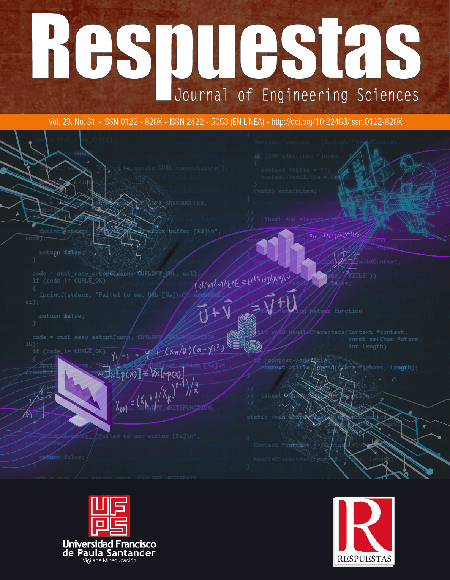Generalities and contribution to the study of the Darrieus type turbines
Generalidades y aporte al estudio de las turbinas tipo Darrieus
Main Article Content
This study presents the procedure of modeling and simulation of a Darrieus rotor with the objective of determining the capacity to take advantage of the energy contained in the water currents for the generation of electrical energy using the model of double disc and multiple stream tubes (DMST). Initially different aerodynamic profiles were analyzed, the profile with the best performance was selected taking into account the coefficients of sustentation and resistance, later these coefficients were extrapolated by Montgomery's method using MATLAB software. In this way, the sustentation and resistance coefficients corresponding to the established operating conditions were obtained, and then these data were used to develop the characteristic curve of the Darrieus rotors solving the mathematical model. Finally, the results obtained from the mathematical model were compared with those obtained through a CFD simulation with the Ansys Fluent software. It was determined that both the mathematical model and the computational simulation generated results similar to the analytical and experimental studies performed by other researchers.
Keywords: CFD,Hydrokinetics,Simulation,Mathematical model
Downloads
Article Details
I. Paraschivoiu, “Wind turbine design with emphasis on darrieus concept” [Diseño de turbina eólica con énfasis en concepto darrieus], P. Polytechnique, Ed., Montréal: 4, 2009.
R. E. Sheldahl y P. C. Klimas, “Aerodynamic characteristics of seven symmetrical airfoil sections through 180-degree angle of attack for use in aerodynamic analysis of vertical axis wind turbines”, México: Board, 1981.
M. S. K. &. K. S. Shiono, “An Experimental Study of the Characteristics of a Darrieus Turbine for Tidal Power Generation [Un estudio experimental de las características de una turbina Darrieus para marea generacion de energia]”, Electrical Engineering in Japan, vol. 132, no. 3, pp. 38-47, 15 Junio 2000.
A. Malipeddi and D. Chatterjee, “Influence of duct geometry on the performance of Darrieus hydroturbine” [Influencia de la geometría de los conductos en el rendimiento de la hidroturbina Darrieus], India: Board, 2012.
M. J. Khan, M. T. Iqbal y J. E. Quaicoe, “Design Considerations of a Straight Bladed Darrieus Rotor for River Current Turbines [Consideraciones de diseño de un rotor Darrieus de hoja recta para turbinas de corriente del río]” IEEE International Symposium on Industrial Electronics, 2006.
H. Rolón O y Y. Villamizar G, “Modelamiento y simulación del comportamiento de rodete tres”, Cúcuta, Colombia, 2017.
E. Rúa, A. Barrera y N. M. Moreno, “Aprendizaje interactivo de termodinámica de fluidos apoyado en las tecnologías de la información y comunicación”, Respuestas, vol. 19, no. 2, pp. 41-50, 2014.
M. Vergel-Ortega, J.J. Martínez-Lozano y E. Ibargüen-Mondragón, “Modelos estimados de análisis de supervivencia para el tiempo de permanencia de los estudiantes de la Universidad Francisco de Paula Santander”, Respuestas, vol. 21, no. 2, pp. 24-36, 2016.
T.J. Celso Range, “Desempeño aerodinámico de turbinas eólicas de eje vertical en función de temperatura de superficie de álabe”. Santiago de Chile, 2012.
Confluence.cornell.edu, “FLUENT Learning Modules -SimCafe - Dashboard,” Universidad Cornell, [En línea]. Available: https://confluence.cornell.edu/display/SIMULATION/-FLUENT+Learning+Modules. Accedido en: 13 Mayo 2017].
J.G. Chacón-Rangel, A.S. Flórez-Fuentes y J.E. Rodríguez-Fernández, “La inteligencia artificial y sus contribuciones a la física médica y la bioingeniería”, Mundo Fesc, vol. 5, no. 9, pp. 60-63, 2015.
C.A. Hernández-Suárez, L.A. Jaimes-Contreras y R.F. Chaves-Escobar, “Modelos de aplicación de ecuaciones diferenciales de primer orden con geogebra: actividades para resolver problemas de mezclas”, Mundo Fesc, no. 11, pp.7-15, 2016.
S. Lain and C. Osorio, "simlation and evaluation of a straight bladed Darrieus type cross flow marine turbine [Simulación y evaluación de una turbina marina de flujo cruzado tipo Darrieus de pala recta]," Journal of scientific & insdustrial Research, vol. 69, pp. 906-912, 2010.
J. Pabón-Gómez, “Las TICs y la lúdica como herramientas facilitadoras en el aprendizaje de la matemática”, Eco Matemático, vol. 5, no. 1, pp. 37-48, 2014.
R.V Hernández, L.F. Mariño y J.O. Cañas, Aprendizaje y formación por competencias del pensamiento numérico, Eco Matemático, vol. 6, no. 1, pp. 22-33, 2015.
J. Martínez-Lozano, H. Gallardo-Pérez y M. Vergel-Ortega, “Inteligencias múltiples y estilos de aprendizaje, su relación con el rendimiento académico de estudiantes en estadística”, Eco Matemático, vol. 5, no. 1, pp.74-86, 2014.
C. Hernández-Suárez, P. Ramírez-Leal y G. Rincón-Álvarez, “Pensamiento matemático en estudiantes universitarios”, Eco Matemático, vol. 4, no. 1, pp. 4-10, 2013.







